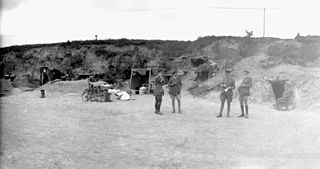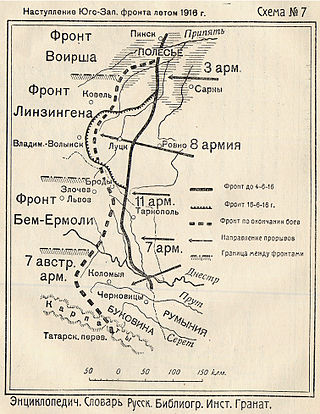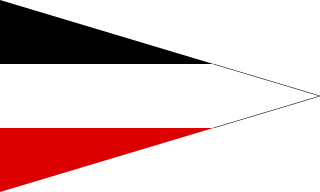
The 10th (Irish) Division, was one of the first of Kitchener's New Army K1 Army Group divisions, authorized on 21 August 1914, after the outbreak of the Great War. It included battalions from the various provinces of Ireland. It was led by Irish General Bryan Mahon and fought at Gallipoli, Salonika and Palestine. It was the first of the Irish Divisions to take to the field and was the most travelled of the Irish formations. The division served as a formation of the United Kingdom's British Army during World War I.

The Canadian Corps was a World War I corps formed from the Canadian Expeditionary Force in September 1915 after the arrival of the 2nd Canadian Division in France. The corps was expanded by the addition of the 3rd Canadian Division in December 1915 and the 4th Canadian Division in August 1916. The organization of a 5th Canadian Division began in February 1917 but it was still not fully formed when it was broken up in February 1918 and its men used to reinforce the other four divisions.
The Canadian Expeditionary Force (CEF) was the expeditionary field force of Canada during the First World War. It was formed on 15 August 1914 following Britain’s declaration of war on the German Empire, with an initial strength of one infantry division. The division subsequently fought at Ypres on the Western Front, with a newly raised second division reinforcing the committed units to form the Canadian Corps. The CEF and corps was eventually expanded to four infantry divisions, which were all committed to the fighting in France and Belgium along the Western Front. A fifth division was partially raised in 1917, but was broken up in 1918 and used as reinforcements following heavy casualties.

The 1st Army was an army-level command of the Russian Imperial Army created during World War I. The First Army, commanded by General Paul von Rennenkampf, invaded East Prussia at the outbreak of war in 1914 along with the Second Army commanded by General Alexander Samsonov. After declaring war on the German Empire, the Russian Empire had been able to mobilize very quickly. All Russian forces were put under the command of Grand Duke Nikolai and his Quartermaster General Yuri Danilov.

The Allies, or the Entente, were an international military coalition of countries led by France, the United Kingdom, Russia, the United States, Italy, and Japan against the Central Powers of Germany, Austria-Hungary, the Ottoman Empire, and Bulgaria in World War I (1914–1918).

The Russian Caucasus Army of World War I was the Russian field army that fought in the Caucasus Campaign and Persian Campaign of World War I. It was renowned for inflicting heavy casualties on the opposing forces of the Ottoman Empire, particularly at the Battle of Sarikamish. It was also known for its extremely diverse ethnic composition, consisting of units from throughout the Russian Empire and both soldiers and officers from the many ethnic communities settled since the 1877-78 Russo-Turkish War in the militarily administered Kars Oblast in the Russian Transcaucasus. These included Georgians, Caucasus Greeks, and Armenians - the latter in particular strongly represented among both the soldiers and senior officers - as well as ethnic Russians and Ukrainians.

The Russian Third Army was a World War I Russian field army that fought on the Eastern theatre of war.
The Russian Sixth Army was a World War I Russian field army that fought on the Eastern theatre of war.

The Southwestern Front was an army group of the Imperial Russian Army during World War I as part of the Eastern Front war theater.
The Twentieth Army Corps was a formation of the Imperial Russian Army that was first raised in 1899, and most famous for fighting on the Eastern Front in World War I, most notably during the Second Battle of the Masurian Lakes. Before World War I, the 20th Corps was stationed in the Vilna Military District with its headquarters in Riga. At the outbreak of the war, the corps consisted of two infantry divisions and a number of independent battalions and brigades. Many Lithuanians served in this unit with the 28th Division having particularly many Lithuanians, especially in the 109th and 111th Infantry Regiments. Some regiments in this Corps were 80% Latvian. The corps was demobilized in April 1917.
The Russian Fourth Army was a World War I Russian field army that fought on the Eastern Front.

The 10th Army was a field army of the Imperial Russian Army during the First World War.
The Russian Fifth Army was a World War I Russian field army that fought on the Eastern Front.
The Russian 11th Army was a World War I Russian field army that fought on the Eastern theatre of war.

The Bavarian Cavalry Division was a unit of the Royal Bavarian Army, part of the German Army, in World War I. The division was formed on the mobilization of the German Army in August 1914. The division was disbanded in 1919, during the demobilization of the German Army after World War I. The division was raised and recruited in Bavaria.

The Russian Eight Army was a World War I Russian field army that fought on the Eastern theatre of war.
The Russian 7th Army was a World War I Russian field army that fought on the Eastern theatre of war.
The Russian Special Army was a World War I Russian field army that fought on the Eastern Front.
The 13th Army Corps was a corps of the Imperial Russian Army, formed in the 1870s. The corps fought in the Russo-Turkish War and World War I, and was disbanded with the collapse of the Imperial Russian Army after the Russian Revolution. During peacetime, it was stationed in the Moscow Military District.

Vladimir Vasilyevich Smirnov was an Imperial Russian Army general of the infantry who was a division, corps and field army commander. He fought in the Russian-Turkish War of 1877–1878 and in World War I.









